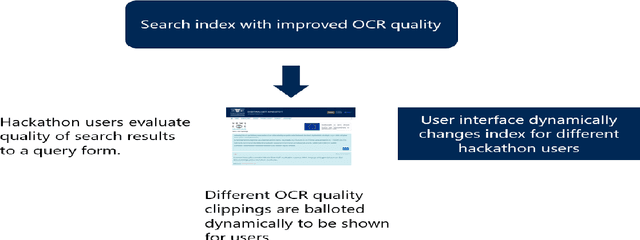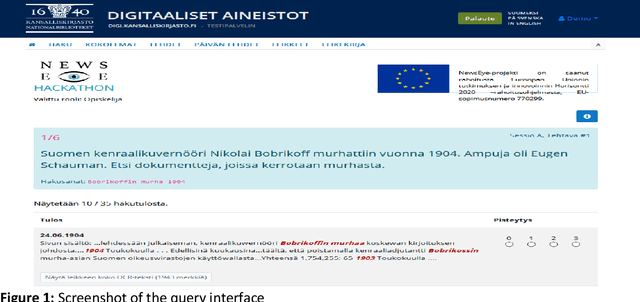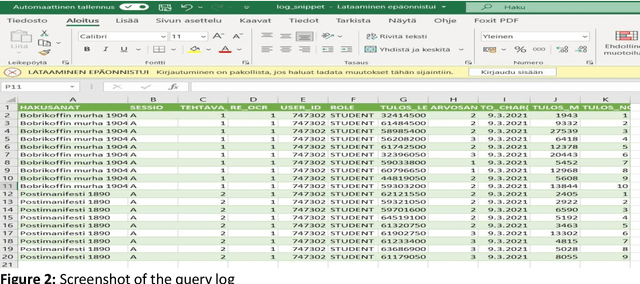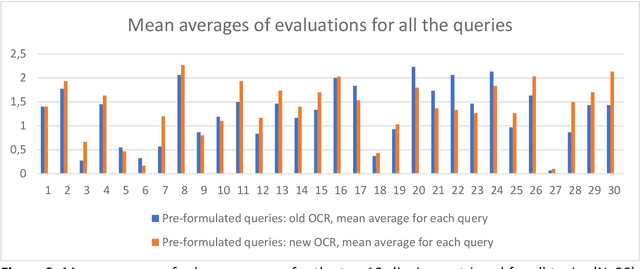Juha Rautiainen
Optical character recognition quality affects perceived usefulness of historical newspaper clippings
Jun 01, 2022



Abstract:Introduction. We study effect of different quality optical character recognition in interactive information retrieval with a collection of one digitized historical Finnish newspaper. Method. This study is based on the simulated interactive information retrieval work task model. Thirty-two users made searches to an article collection of Finnish newspaper Uusi Suometar 1869-1918 with ca. 1.45 million auto segmented articles. Our article search database had two versions of each article with different quality optical character recognition. Each user performed six pre-formulated and six self-formulated short queries and evaluated subjectively the top-10 results using graded relevance scale of 0-3 without knowing about the optical character recognition quality differences of the otherwise identical articles. Analysis. Analysis of the user evaluations was performed by comparing mean averages of evaluations scores in user sessions. Differences of query results were detected by analysing lengths of returned articles in pre-formulated and self-formulated queries and number of different documents retrieved overall in these two sessions. Results. The main result of the study is that improved optical character recognition quality affects perceived usefulness of historical newspaper articles positively. Conclusions. We were able to show that improvement in optical character recognition quality of documents leads to higher mean relevance evaluation scores of query results in our historical newspaper collection. To the best of our knowledge this simulated interactive user-task is the first one showing empirically that users' subjective relevance assessments are affected by a change in the quality of optically read text.
OCR quality affects perceived usefulness of historical newspaper clippings -- a user study
Mar 04, 2022



Abstract:Effects of Optical Character Recognition (OCR) quality on historical information retrieval have so far been studied in data-oriented scenarios regarding the effectiveness of retrieval results. Such studies have either focused on the effects of artificially degraded OCR quality (see, e.g., [1-2]) or utilized test collections containing texts based on authentic low quality OCR data (see, e.g., [3]). In this paper the effects of OCR quality are studied in a user-oriented information retrieval setting. Thirty-two users evaluated subjectively query results of six topics each (out of 30 topics) based on pre-formulated queries using a simulated work task setting. To the best of our knowledge our simulated work task experiment is the first one showing empirically that users' subjective relevance assessments of retrieved documents are affected by a change in the quality of optically read text. Users of historical newspaper collections have so far commented effects of OCR'ed data quality mainly in impressionistic ways, and controlled user environments for studying effects of OCR quality on users' relevance assessments of the retrieval results have so far been missing. To remedy this The National Library of Finland (NLF) set up an experimental query environment for the contents of one Finnish historical newspaper, Uusi Suometar 1869-1918, to be able to compare users' evaluation of search results of two different OCR qualities for digitized newspaper articles. The query interface was able to present the same underlying document for the user based on two alternatives: either based on the lower OCR quality, or based on the higher OCR quality, and the choice was randomized. The users did not know about quality differences in the article texts they evaluated. The main result of the study is that improved optical character recognition quality affects perceived usefulness of historical newspaper articles significantly. The mean average evaluation score for the improved OCR results was 7.94% higher than the mean average evaluation score of the old OCR results.
 Add to Chrome
Add to Chrome Add to Firefox
Add to Firefox Add to Edge
Add to Edge